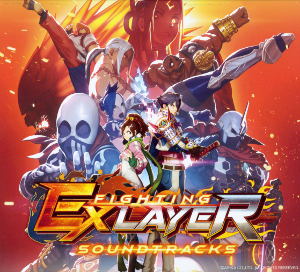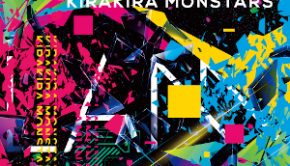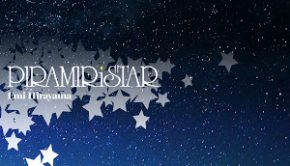FIGHTING EX LAYER Soundtracks
 |
Album Title: FIGHTING EX LAYER Soundtracks |
| Record Label: Sweep Record |
|
| Catalog No.: SRIN-1160 |
|
| Release Date: December 12, 2018 |
|
| Purchase: Buy at Sweep Record |
Overview
One could say that the FIGHTING EX LAYER Soundtracks is a work 22 years in the making. Not only does it feature the soundtrack to the recently crowdfunded fighting game Fighting EX Layer, it also features the music from the original Fighting Layer and the three EX games, originally released under the moniker Street Fighter EX. Across 7 discs, and a bonus DVD containing multitrack data from the original console version of EX and some PDFs, it features the original soundtracks to all the fighting games developed by Arika, some of which are also used as stage music options in the game itself. Featuring an all star team of Takayuki Aihara, Ayako Saso, Shinji Hosoe, Takahiro Eguchi, Fumihisa Tanaka, and Yasuhisa Watanabe, in various contributory roles, across the entire release, it is the definitive collection for the music of Arika’s fighting game soundtracks. How is the final package and how does the new music hold up to the original games’ soundtracks created so many years ago.
Body
Fighting EX Layer
Released in 2018, Fighting EX Layer sees the return of Arika to the fighting game scene. In addition to the three composers featured in previous games, Ayako Saso, Takayuki Aihara, and Shinji Hosoe, the soundtrack also features music from younger Supersweep members Takahiro Eguchi and Fumihisa Tanaka. Ayako Saso’s “EXL Main Menu” keeps with the traditions of the past games with its funky bass, soft synths, and jazzy tones. Her other contributions, stage themes, also pack quite a punch. “Collapsed Castle” features Japanese instrumentation such as shakuhachi and shamisen (or koto) alongside a rock base. The synthesizer sections are also quite enjoyable and the end result is a tune with a fantastic melody. “Overcome Fists” is an amalgam of sounds blending jazzy funk, big band horns, electric guitar, keyboards, and synthesizer for a excellent mash up that also gives off a sense of tension as it progresses. The electric guitar section, in particular, is of note. Lastly, “Deck Brawl” is an energetic synth rock tune with a fantastic melody, especially on the electric guitar, and some strings, jazzy piano, and electronic accompaniment. It’s a stellar tune and the solos also make for an excellent listen.
Takayuki Aihara contributes a single stage theme, “Passionate 549,” and it makes me wish more of him was on the soundtrack. It has a synth/retro sound to it with a bright melody alongside a slight rock accompaniment. However, the B section is where the piece truly shines with its more orchestral lean and fantastic melody. It’s exquisitely done and one of the highlights of the album. Shinji Hosoe also only contributes a small portion to the soundtrack. His “EXL Result” and “The GOUGI” are both shorter tunes with the former being a bright synth rock tune with a beautiful atmosphere that conjures up images of recollection, but isn’t extremely forward in its approach to melody. The latter blends funk, chimes, jazzy piano, and soft synths for a more atmospheric approach. His stage theme, “Raven Cave,” is another highlight of the album. It’s a synth rock tune with a fantastic melody, catchy synths, and definitely sounds like it came right out of an earlier game in the series. As it approaches its loop, a great electric guitar solo is introduced and although its on the shorter side, it gives the tune a nice new dynamic. Although present on a couple of collaborative compositions, Fumihisa Tanaka’s solo contribution, “Wild Fighting,” is an enjoyable one. It’s a rock tune, but where it thrives is in how its implemented in the beginning. The e. guitar alongside drums gives it a bit of a dance vibe, as if it was an electronic tune that decided to transform itself into a rock tune. As the piece progresses, it takes on a more Japanese aesthetic with the introduction of a Japanese flute in the melody line.
Another major solo contributor is Takahiro Eguchi. Starting with “EXL Select,” it’s a motivating rock tune, but like most character select screens, lacks any meaningful development. “Moonlit Night Castle,” related to Saso’s “Collapsed Castle,” is a rock oriented tune mixed with Japanese instrumentation. It’s an engaging tune with lots of drum percussion. The melody itself is quite catchy and the piano and its harmonies are quite lovely. “Under the Railway” may be my favorite tune on the soundtrack. It has a jazzy funk/rock feel to it accompanied by synthesizer. The melody, on guitar, is super fun and quote memorable while the solos and bass guitar are particular highlights as well. “Bloody Sluice Gate” is a synth rock tune with beautiful piano passages, plenty of percussion, and a funk rock jam. The guitar work is excellent and the Japanese instrumentation adds a nice contrast to the piece. The B section is a bit more J-rock/anime inspired and is quite catchy. “Leaked Two Fists” is another rock tune, this time with a more J-rock sound. Alongside the rock are some beautiful synth and piano melodies that really help elevate the tune overall. Lastly, “EXL Terry Bogard’s Theme” is an energetic rock interpretation with some jazzy tones of the original, first featured in Fatal Fury series.
The rest of the stage themes are collaborations between Takahiro Eguchi and Fumihisa Tanaka. Among the weakest is “To Be Extremely,” likely the training stage. It’s a synth driven tune with slap bass, but suffers from repetition. To its credit, as it progresses, it does gain some complexity by adding additional layers to it, but it doesn’t culminate into something as invigorating as a lot of the other tunes on the album. “Wandering Train,” related to “Under the Railway,” keeps the same funk approach as the original but has a softer sound overall. Within the melody itself is a beautiful guitar soundscape and the end result blends some jazz influence and has a bit of a soulful touch to it as well. “Blind Moss” is another rock oriented tune blended with synthesizser. It has a gritty feel to it and is certainly less melodically focused as other tunes on the soundtrack. Riffs are more prominent and while the synth and electric guitar melodies are strong, when present, they do take some time to appear. “Extreme Great Canyon” has a metal influence, especially in the accompaniment, but also has a soulful sound while the synth melody is more of a complementary element. The end result is a tune with a great vibe. Lastly, “Raging Deck” is a frenetic rock tune with a focus on tempo. The melody itself is quite strong and I personally enjoy the shift to a jazzier rock sound in the B section. It works quite well and gives the piece a bit more sophistication and soul. It’s another excellent tune.
EX/EX Plus
Released in 1996, EX/EX Plus contains the music for the Street Fighter EX/EX Plus games. Although not directly tied to Capcom’s fighting series, as it was developed by another company, Arika, there were some characters from that series that made its way into this series of games. Composed by Takayuki Aihara, Ayako Saso, and Shinji Hosoe, it establishes a sound that is present throughout the remaining games in the series. Aihara’s “Street Fighter EX” is a short intro tune with a synth rock feel, but doesn’t really excite. However, his stage themes are generally well regarded. “Rising Dragoon” blends synth rock with Japanese instrumentation to create an exhilarating feel alongside a great melody while “Amusementive Crime” blends synth rock with industrial tones and synth stabs to create a wonderful atmosphere. There are some aspects to the piece that are a bit more playful in tone, but I feel these clash a bit with the rest of the tune. A personal favorite, “Arabesque,” is clearly Middle Eastern in influence, both in terms of melody and instrumentation. The mix of synthesizer and orchestra helps lift up an extremely bubbly melody. It’s a classic that has been seen in other Arika titles, such as Technictix. “God Hands” is more chaotic and industrial in approach with a lesser focus on melody and a more ominous tone, but the end result is a bit weak. Another synth rock tune that blends Japanese instrumentation is “Irreconcilably.” It’s energetic tempo and keyboard usage gives it a prog rock sound while the guitar riffs give it a more ominous tone.
Starting with “Character Select,” Ayako Saso provides another synth rock tune with a motivating sound. The rest of her contributions are largely stage themes. “Hikari no Shugoshin” blends a fantastic synth melody with funky slap bass to create a tune that is, at times, bright and, at others, more tense. “Garnet sky” is a Spanish flavored tune with bright synths, flamenco guitar, castanets, and brass. It has a great soundscape but the melody itself isn’t one of the stronger ones on the album. “Cold pipe” is more industrial in sound with cold synths and a melody that provides a tense soundscape but is quite pleasant to listen to. “Strange sunset” is a synth tune with a fun vibe and decent melody that blends jazzy piano to create an enjoyable atmosphere. Lastly, “Staff roll” blends a big band jazz sound with a funky retro feel to create another fun tune. Shinji Hosoe, responsible for the least amount of tunes on the original EX game, opens with “Yozakura Mankai,” blending slap bass with Japanese flute, shamisen, and synthesizer to create a bright soundscape while the largly synthesized B section provides an airy feel. “Tenkyaku Buka” is a synth rock tune with a great melody that’s quite memorable. Of note are the bell-like sections mixed with the synthesized melody. The end result is quite catchy. “Under tube” features smooth bass guitar and crystalline synths to create a great atmosphere and a more mysterious tone. Lastly, “Stronger” features a strong melodic focus with synths leading the way with an industrial tone created by the various synth stabs heard throughout.
After the initial release, an update, EX Plus, was released and with it came a few things. First, the arrangements featured are more crisp and are expanded upon version of the original, sometimes with new instrumentation. However, in addition to these, each composer added a new stage theme to the mix. Aihara’s “Precious Heart” is a jazzy rock tune with synthesizer, saxophone, and electric guitar. It’s a smooth sound with a fantastic melody. It is, at times, a bit too schmoozy, but the end result is generally fun to listen to. Saso’s “Heat wind” has a desert-like sound to it, blending rock with sitar to excellent effect. The melody itself is fantastic and the end result is quite powerful. Lastly, Hosoe’s “Future Objects” blends quirky synths alongside a spacey soundscape. The atmosphere itself is quite chill and the tune has a beautiful soundscape from start to finish.
EX2/EX2 Plus
Released in 1998, EX2 (and later EX2 Plus) went under the moniker Street Fighter EX2/EX2 Plus. The same trio of composers, Takayuki Aihara, Ayako Saso, and Shinji Hosoe were once again responsible for the soundtrack, with this one adding a lot of different sounds compared to the first game. Aihara’s opener, “Street Fighter EX2” is another short synth rock ditty with a ton of energy. However, the meat of his music is, once again, stage themes. “The Infinite Earth” is an excellent synth rock tune with a strong melody, catchy sound, and slap bass that also combine with some softer synth tones. The end result is an exhilarating listen. “Mahatma Temple with Hymn” blends organ, choir, and rock to create a tense, slightly ominous, and slightly angelic sound to create a very dynamic piece of music. “Amusementive Crime 2,” a sequel to the track from the original game, is improved with an industrial backbone, soft synths, a great rhythm, and a synth driven melody.
Saso’s “White Field” has a crystalline and icy sound with its synth melody and accompaniment. There are some rock riffs present and the B section definitely has a more dance feel to it. The end result is quite beautiful and highly enjoyable. “Lost Sea” has a very Streets of Rage sound to its accompaniment while the melody meanders from a mysterious synth driven to a more jazzy one as it progresses. It’s quite an enjoyable and relaxing tune. “Passage of Lotus” features a tense accompaniment alongside a synth driven melody with a bright sound and some excellent drum rhythm. Her “Crash Power Plant” tune blends an industrial sound, primarily in the percussion and sound effects, alongside a rock influence. It’s a bit chaotic sounding at times, and the melody is lacking, but the atmosphere is what makes this piece. Lastly, “Crowded Town” is an Asian inspired tune, both in instrumentation and melody, alongside some synth tones. It’s an extremely strong piece.
Both “Pearl in the Sky” and “Three Tree,” by Shinji Hosoe, blend Japanese instrumentation alongside synthesizer. The former has an interesting progression and jazzy piano while the latter has a more earthy feel and ambiance, thanks to the Japanese flute. “Flash Train” is a synth forward tune with a smooth melody, intricate drum rhythms, and a memorable listen overall. Another tune that is used in future Arika titles is “Fake World,” blending sitar, quirkky synths, and bass guitar for a funky listne with some synth sections providing a more ambient approach, giving the tune a great atmosphere from start to finish. Lastly, “More stronger” has a similar sound to the EX version. It’s tense, mechanistic, and features an invigorating synth melody.
In 2000, EX2 Plus was released and in addition to the music featured in the original, each composer contributed a few new tunes to the mix. Aihara’s ” Digital Ignition” and “Irene” are in stark contrast to one another. The former is a bubbly synth melody with rock accompaniment that transforms into a more orchestral B section. The latter is an accordion driven tune blended with synth accompaniment alongside ethereal strings work. The atmosphere is absolutely exquisite and eventually features a tenser B section thanks to some synth stabs that are present. Saso’s “Frozen Mist” blends rock riffs alongside white noise, groovy bass, and synthesizer to create a fantastic and powerful atmosphere. “Green Shower,” due to its instrumentation, has a tropical vibe to it alongside jazzy piano and synths, giving the overall piece a bright soundscape that’s accentuated by the big band influence. Lastly, her “The Battle of the Flame” has a more Middle Eastern aesthetic to it mixed with synth rock. The end result is an arcade-y thanks to the synthesizer sections that help augment the tune in general. Hosoe crafted two new tunes for the updated version, “Before Moon” and “Phantom Bomb.” The former starts with a jazzy base and a bubbly synth melody, giving the piece a great energy, especially during the downtempo sections. It’s a highly entertaining piece of music. The latter is a gritty rock tune with ambient synths. It’s a moody piece with a soft, but ominous, sound.
EX3
Also released in 2000 was the Playstation 2 title, Street Fighter EX3. In addition to the core composers of Takayuki Aihara, Ayako Saso, and Shinji Hosoe, Yasuhisa Watanabe joined to help craft the soundtrack. Starting with Aihara’s “Attract Demo,” the soundtrack leads with another short ditty with an exciting sound, this time with a more funk rock approach. His “Iron Eyes” features bright and bubbly synths and light percussion that help support a catchy melody while “Ancient Zone” blends soft, ethereal synths with violin and a slower tempo to create a beautiful soundscape with an exquisite melody and a slow jam guitar solo as well. “Matador” has Spanish flair blending orchestral tones with flamenco and synth, particularly in the B section, resulting in a memorable listen that also features some jazzy piano. Lastly, his “Street Fighter EXXX” theme features gritty rock riffs with a Japanese influenced melody and jazz to create a nice blend of sounds.
Yasuhisa Watanabe’s “Player Select” features warm synths, slap bass, and smooth jazz guitar to create an enticing soundscape to kick off his contributions. “Move” is another tune with a softer sound featuring drum pad and warm synths atop a jazzy undertone. The melody itself is quite nice and the atmosphere created is quite beautiful. “Harem Beat” features big band jazz influences alongside slap bass, soft synths, and funk that help craft another tune with a great melody and atmosphere while “Cute Mafia’s” jazzy piano and quirky synth melody falters a bit. While the melody is decent, it’s not quite as strong as others on the album, but it does have a cutesy feel to it. “Burry Home” features erhu and funky synthesizers, making for an odd juxtaposition that is an enjoyable listen in the end. Lasty, “Add on Love Tree” is a warm synth tune with a memorable melody, a futuristic vibe, and an ethereal touch.
Ayako Saso provides three stage themes to the soundtrack. “Temptation Gun” is a groovy rock tune with a synth led melody that give off a quirky, yet jazzy sound. The tune is, in general, a fun one with lots of great energy. “BIRI-BIRI Red heat” features jazzy piano and brass and combines it with flamenco guitar and an, at times, tropical feel. There is definitely a wonderful atmosphere here alongside an excellent melody, especially during the guitar sections. Lastly, “Final Battle” is a dramatic orchestral tune with drum pad and organ. In addition, a cold, industrial accompaniment alongside jazz piano and some prog rock influence makes for some great solos and an excellent tune overall.
Contributing an additional three stage themes is Shinji Hosoe. “Coolman Rosso” blends accordion, marimba, rhythm guitar, and some jazzy accompaniment for a smooth sound and a great melody. The tune is quite entertaining and the bass guitar helps give it a bit of funk as well. “Indra Bridge of TA-SO-GA-RE” is a rock tune with a gritty feel, but with a bit of groove as well. THe main melody is quite strong and there is a definite prog rock feel to it, especially along the excellent solos. Lastly, “Great Stronger” blends jazzy piano, shakuhachi, and futuristic synths alongside moments of calm. It’s an odd combination, but is quite enjoyable.
Fighting Layer
The first Fighting Layer, released in 1998, was composed by Takayuki Aihara and Ayako Saso and has ties to the other soundtracks on the release, with Aihara providing much of the first soundtrack’s tunes. “Emblem of Dragon” is an orchestral fanfare with synths and a jazz influence while “Character Select” is a jazzy synth rock tune that is short, but satisfying. The rest of his contributions are largely character themes (stage themes). “George Jensent” is a synth rock tune with a super memorable and catchy tune with e. guitar proving a lot of energy while “Lan-Yinghua” has a softer jazz influence and is a synth driven tune with a bright atmosphere. There are also some e. guitar elements and a smooth sound, alongside some Asian influence in the melody. “Tetsuo Kato” is another catchy synth rock tune that hooks the listener immediately. Its bright soundscape is an iconic tune and is extremely memorable overall. “Sessyu Tsukikage” with a Japanese inspired melody alongside jazzy synths, groovy slap bass, and drum pad. The synth strings help add some tension to the piece while the e. guitar helps bring some edge to the piece.
“Exodus” is a mish-mash of sounds, featuring synth rock and orchestral elements, for a tense and dramatic sound. However, there are some jazzy piano tones and the melody itself has an ethereal and subtle aspects to it. The B section is more prominent with its rock riffs and synth melody. Big band inspiration and jazzy synths dominate “Allen Snider,” and its melody, while not stand out, is enjoyable. “Claire Dame” is full of jazzy funk and a beautiful synth melody with smooth brass sounds and an overall great vibe while “Vold Ignitio” is more of a slow jam with jazz tones. The piece itself is more atmospheric, relying less on melody, although it is still present, but the end result is quite exquisite. Aihara is also responsible for the main theme, “Fighting Layer,” a tune that combines aspects of slow rock, funk, and jazz with a decent melody that gives a nice idea of what to expect for the rest of the soundtrack.
Ayako Saso has a smaller, but no less impactful role, on the music of the series. “”Hong Gillson” is a fun jazz influenced tune with a funk accompaniment and a big band sound alongside a great synth melody while “Janis Luciani” is more spy-like with a sense of mystery before diving head first into a synth rock tune with a great e. guitar sound. “Jigjid Bartol” is a softer tempo jazz tune with a decent melody and a great groove while the B section’s more rock oriented melody is a nice way to break up the flow. “Cappricio” has a bit of a chaotic carnival sound with jazzy piano and groovy funk rock in the accompaniment while the synth melody has more of a fun tone to it that helps complement the accompaniment. “Shang-Fenghuang” is another jazz funk tune with a strong e. guitar focus and gritty rock riffs alongside a synth melody while ” Human” is another big badd jazz sound with synthesizer and funk rhythm. It’s one of the weaker tunes from Saso, but the slap bass is quite enjoyable. Lastly, “Animal” features industrial tones, funk, and rock, with a sense of tension, but is also a bit lackluster with its weaker melody.
Summary
The FIGHTING EX LAYER Soundtracks is an excellent release and should be in the collection of anyone who is a fan of Supersweep’s work. The older games, re-released for this compilation, are nostalgic, yet still fresh, and contain a numerous amount of iconic tunes. However, the Fighting EX Layer soundtrack, all of which is released for the first time, is also quite enjoyable. It bears the hallmark of the EX series, thanks in part to the contributions of Saso, Aihara, and Hosoe, but the new music by Eguchi and Tanaka are also fitting with the series while also providing a fresh perspective to the series’ identity. It is on the pricier side, but it’s definitely worth it as some of the earlier soundtracks may be harder to track down and having everything in one convenient package is also a plus.
Do you agree with the review and score? Let us know in the comments below!
4.5
Posted on January 31, 2019 by Don Kotowski. Last modified on January 31, 2019.














